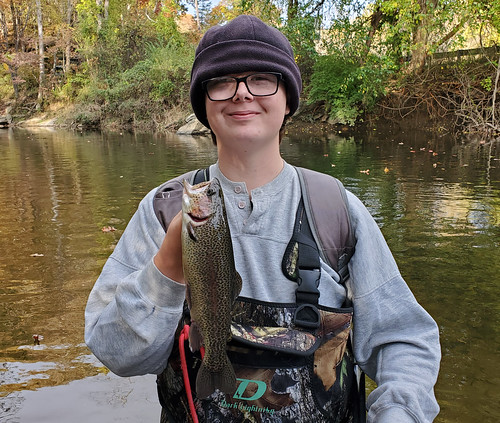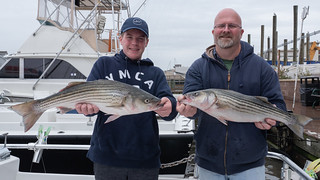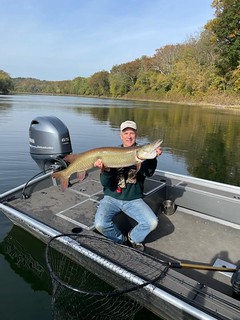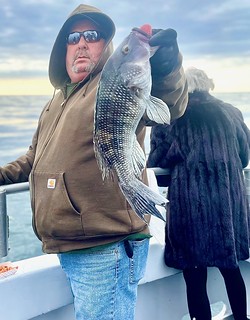
Jacob Baczeski went trout fishing with his dad on Deer Creek and proudly holds up a rainbow trout he caught. Photo by Stanley Baczeski
November is upon us and many areas of central, southern, and eastern Maryland have experienced their first frost. The waters are cooling and providing excellent fishing opportunities as many species of fish are feeding aggressively. The Maryland Department of Natural Resources trout program made an all-out effort to stock waters last week, providing exciting fishing.
Forecast Summary: November 3 – November 9:
As Daylight Savings comes to an end on Sunday morning, expect some sunny, cool and breezy days and cool nights. Bay has passed the turnover period, so now surface waters and Bay rivers will cool faster than the bottom waters. As bait moves out of the cooling rivers — now in the mid-50s — in search of warmer waters that are now deeper, gamefish will be close behind. Bay surface water temperatures have dropped to the lower 60s.
The improved oxygen and water temperature conditions will continue to provide anglers great opportunities to catch fish in shallower waters and river mouths, ambushing bait moving out of cooler rivers into the warmer main Bay waters. In addition, the traditional places deeper in the water column such as channel edges, underwater points, hard bottom, and drop-offs will also be productive.
There is suitable oxygen to the bottom in all of Maryland’s Bay waters. Upper Bay waters down to Tilghman Island are running fresher than normal.
Expect normal flows for most Maryland rivers and streams except the Potomac and Susquehanna rivers. There will be above average tidal currents all week due to the new moon on Nov. 5.
Expect poor water clarity caused by recent rains on the main Bay from Tolchester north to the Conowingo Dam. Expect poor water clarity for the Northeast, Bush, Back, Patuxent, and upper Patapsco rivers due to algal blooms. Expect good water clarity for other Maryland rivers and main Bay areas. To see the latest water clarity conditions, check Eyes on the Bay Satellite Maps.
For more detailed and up-to-date fishing conditions in your area of the Bay, check the Maryland DNR website for Click Before You Cast. Get regular updates on Maryland’s waters sent to your inbox with our Eyes on the Bay newsletter. Sign up online.
Upper Chesapeake Bay
The upper Bay will continue to feel the effects of last week’s deluge and strong winds for a while. The Conowingo Dam has been dumping a lot of water since October 28 and the wind-driven high tides of last week caused a lot of floating debris for boaters to avoid.
Conditions are improving, and fishing for striped bass may be in better shape by the weekend. Noisy crankbaits would be a good choice. Also, the water clarity is a little better on the eastern side of the Bay, and the mouths of the tidal rivers should offer good morning and evening casting opportunities for striped bass.
The Love Point rocks and the mouths of the Patapsco, Magothy, and Chester rivers are good locations to cast soft plastic jigs and paddletails and work them along the bottom for striped bass. Keeping a close watch on a depth finder is also a good tactic to look for striped bass suspended along steep edges of the shipping channel.
Trolling can also be a good option, with most using umbrella rigs behind heavy inline weights rigged with swimshads or bucktails dressed with soft plastics as trailers or small spoons behind planers. The larger fish tend to be suspended deep along channel edges. Breaking fish may be spotted at times but they are usually striped bass in the 17-inch size range. The Triple Buoys area, Swan Point, Love Point, Brewerton Channel, and Podickory channel edges are all good places to explore.
Fishing for a mix of channel and blue catfish is good as ever this week from the mouths of the Susquehanna River and Elk River south. Most any kind of fresh bait in the form of cut bait, chicken liver, clam snouts, or nightcrawlers will work. White perch are reported to be a bit difficult to find recently; the lower Patapsco and Chester rivers are two of the better places to fish for them in deeper waters.
Middle Bay

Howard Townsend and his nephew Linus Byrns hold a pair of striped bass they caught near Tilghman Island. Photo by Stephen Badger
The Bay Bridge is providing good striped bass action through a variety of fishing options. Those that can find or still hold spot are live lining at the bridge piers with good success. Finding small white perch tends to be a little easier and they will work well in a pinch. Others are drifting cut bait back to the pier bases with success and still others are using live eels — all are working well.
Casting skirted soft plastic jigs near the pier bases is another effective way to fish for striped bass at the bridge. Jigs are cast tight to the bridge piers and allowed to sink to an appropriate depth before being worked. If your jigs don’t have some paint chipped off them you’re not casting close enough to the concrete piers. The sewer pipe just north of the east side of the bridge is also a great place to cast jigs.
The Eastern Bay area and the Miles River are great places to cast paddletails, jerkbaits, and topwater lures in the morning and evening hours along shoreline structure. Jigging along the channel edges leading out of the Miles and along the Poplar Island rocks is also a good tactic. Shorebound and boat anglers are enjoying good striped bass action at Kent Narrows by casting and working soft plastic jigs along the bottom in the swift currents. The same good fishing can also be found at the mouths of the Choptank and Severn rivers.
The shipping channel edge in front of Thomas Point, Chesapeake Beach, Buoy 83, and the False Channel are all excellent places to jig soft plastics. A good tactic is watching one’s depth finder while slowly cruising along various channel edges looking for suspended striped bass. They can be found most anywhere at any time along major channel edges.
Breaking fish are being encountered throughout the middle Bay. The majority of them are small striped bass mixed with a few remaining bluefish, chasing schools of bay anchovies and juvenile menhaden as they exit the tidal rivers. The schools of bait are being swept along the channel edges by swift currents that the striped bass have no problem navigating.
Fishing for white perch near the mouths of the tidal rivers has settled into targeting oyster reefs and mounts where the perch are schooling in deep water. When the schools of perch are located on depth finders, most anglers are using bottom rigs baited with pieces of bloodworm or dropper rigs with small flies or soft plastics.
Lower Bay

Herb Floyd sent us a picture of what is on the menu for striped bass this week — juvenile menhaden from the stomach of one 25-inch striped bass. Photo by Herb Floyd
The lower Bay is full of fishing opportunities this week — a mix of striped bass and bluefish are spread along channel edges; the last of the large and slot-sized red drum along with speckled trout continue to linger in the east side of the Bay, and speckled trout and slot-sized red drum are in the lower Potomac River.
There is lot of fun fishing for a mix of striped bass, slot-sized red drum, and speckled trout to be had by casting topwater lures, jerkbaits, and paddletails in the morning and evening hours along the shorelines of the lower Potomac and Patuxent rivers, and on the eastern shorelines from Hoopers Island south to the Pocomoke Sound.
Trolling is a good option along channel edges of the shipping channel in the Bay and the steep channel edges in the lower Potomac and Patuxent rivers. Umbrella rigs pulled behind heavy inline weights with bucktails or small Drone spoons are popular, as are single Drone spoons behind planers. The better grade of striped bass are holding deep. The breaking fish that are being seen in the region are mostly bluefish and smaller striped bass.
Jigging underneath breaking fish can often produce larger striped bass, which are holding close to the bottom in the channel areas where bait schools are being swept along by currents. Soft plastics can be a great choice if the bluefish are not too thick, otherwise metal jigs may be a better choice.
Freshwater Fishing

Jeff Goetz holds up a beautiful upper Potomac muskie before slipping her back into the river. Photo courtesy of Jeff Goetz
There are plenty of good put-and-take trout fishing opportunities available. The DNR trout program and stocking crews made a Herculean effort to stock 16 small ponds and lakes in Calvert, Cecil, Charles, Caroline, Prince George’s, and Washington counties last week. These community ponds provide a wonderful location to take our younger anglers for a trout fishing experience. These areas are easily accessible and relatively easy to fish. Be sure to check the DNR trout stocking page link and map for locations.
Anglers at Deep Creek Lake are seeing the coldwater fishery there jumping to life. Northern pike are active in the open cove areas, walleye are approaching steep rocky shores in the evenings, and yellow perch can be found along deep grass edges. A variety of large spinnerbaits, jerkbaits, and spoons work well for the northern pike. Small crankbaits and diving jerkbaits are a good choice for walleye, and minnows will work well for both walleye and yellow perch. Smallmouth bass are being found along transition edges where they are on the prowl for crawfish, which are moving from the shallow areas where the grass is declining and headed for deeper structure to wait out the winter months. Tubes, small crankbaits, and soft plastic craw jigs are good choices to imitate crawfish moving along the bottom. Largemouth bass can also be found in many of the same areas of smallmouth bass, often close to sunken wood.
The upper Potomac River is in good shape after last week’s uptick in water levels. Water temperatures are ideal for smallmouth bass and they are feeding aggressively on baitfish and crayfish. Small crankbaits, tubes, and craw jigs are excellent choices for baits to be cast near submerged ledges, current breaks and deep holes. The cooler water temperatures are also more forgiving for muskellunge catch-and-release fishing. They have a much better chance of survival in the colder water temperatures.
Largemouth bass are feeling the cooler water temperatures and are in their aggressive fall feeding pattern. Anglers can take advantage of this by working the transition waters between the shallows and the deeper drop-offs. Largemouth bass will stick to submerged wood waiting for crayfish and small baitfish headed for deeper cover as the grass beds diminish. Small crankbaits, soft plastic craw jigs, jerkbaits and spinnerbaits can all be good choices in these areas. As the afternoon sun warms up the shallower areas, largemouth bass and northern snakeheads can be found soaking up the warmth of the sun. Casting lipless crankbaits, buzzbaits and soft plastics can often work well in the shallower waters.
Crappie are now schooled up near submerged structure. Bridge piers, sunken wood, fallen tree tops, and marina docks are all good places to drift small minnows or marabou jigs under a slip bobber. The tidal Potomac from the Wilson Bridge spoils area down to the Fort Washington Marina and the bridge piers at the Liberty Reservoir fishing pier are among the many areas where crappie can be found.
Atlantic Ocean and Coastal Bays

Anglers wear all kinds of outdoor clothing to keep warm this time of the year, Hats off to the woman wearing a fur coat, one way to stay warm. Photo by Monty Hawkins
Last week’s Nor’easter really stirred up the surf and prevented most anyone from surf fishing without a lot of lead to hold bottom. Often during these heaves, surf clams will be dislodged and striped bass, black drum, and red drum will take advantage of the feast. Pieces of surf clam also make good baits for the spot and kingfish that may still be lingering in our waters. Surf conditions have calmed down and this weekend should hold promise for striped bass and bluefish.
At the inlet, tautog are showing up in greater numbers this week at the jetties and Route 50 Bridge. Sand fleas tend to be the bait of choice and the transition from high tide to slack and an outgoing tide are reported to offer some of the best fishing success. Flounder fishing is good at the inlet — casting Gulp baits and working them along the bottom is a winning tactic. Casting soft plastic jigs and bucktails near the jetties is producing catches of striped bass and bluefish.
The coastal bay waters are clearing up from last week’s storm and flounder fishing is good. Most are drifting in the channels leading towards the inlet as flounder begin their migration to offshore waters for the winter months. Those fishing smaller baits are reporting a high percentage of throwbacks; larger baits can often discourage smaller flounder and target the larger fish.
Fishing for black sea bass at the offshore wreck and reef sites continues to be excellent, with limit catches of chunky sea bass being common around the rails of party boats. Triggerfish and even a few cutlass fish are part of the mix. Those targeting flounder around the wreck and reef sites are catching some large ones. Farther offshore at the canyons the yellowfin tuna fishery is just about finished, and it will not be long before migrating bluefin tuna will be moving south along the 30-fathom line. Deep dropping for a mix of golden and blueline tilefish continues to be very good.
“Always it was to be called a fishing rod. If someone called it a pole, my father looked at him as a sergeant in the United States Marines would look at a recruit who just called a rifle a gun.” — Norman MacLean, 1976
Maryland Fishing Report is written and compiled by Keith Lockwood, fisheries biologist with the Maryland Department of Natural Resources.
Click Before You Cast is written by Tidewater Ecosystem Assessment Director Tom Parham.
This report is now available on your Amazon Echo device — just ask Alexa to “open Maryland Fishing Report.”
